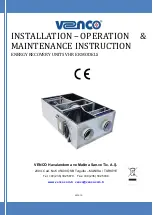
8
519FG09A
reset feature does not, however, eliminate another important
facet of good maintenance, namely, periodic cleaning and
inspection of the internal valve parts.
In the event that water builds up inside the valve due to
condensate from the air supply system or water left inside
from valve system testing, a drain is available for venting.
After closing the main supply valve, a small valve over the
drain cup can be opened slightly until the water inside the
valve body and the main pipe column has drained. See the
section titled “Draining Excess/Condensate Water From
System” in this bulletin for the detailed procedure.
The Model B Manual Emergency Station (see Fig. 4) is also
included in the Reliable Type D Double Interlock Preaction
System trim sets. It consists of an aluminum nameplate
mechanically attached to a ball valve. The valve handle in its
OFF position is guarded against accidental turning to the ON
position (and system discharge) by a nylon cable tie provided
with each trim kit. The cable tie is inserted, as shown in
Fig. 4, after the system has been restored for operation. The
nylon cable tie is designed to allow, in case of an emergency,
forceful turning of the valve handle to the ON position. As
an alternative to the Model B Hydraulic Manual Emergency
Station, the Model A Hydraulic Manual Emergency Pull
Box (see Reliable Bulletin 506) is also available and can be
provided as an option.
Whenever ambient temperature conditions are high, the
water temperature in the Model DDX Deluge Valve’s pushrod
chamber could possibly increase, thereby increasing the
pressure in the chamber to values exceeding the rated
pressure of the system. In an indoor installation where
standard room temperatures are exceeded, a pressure relief
kit may be needed. Pressure relief kit, P/N 6503050001, can
be installed into the pushrod chamber’s releasing line to limit
the pressure to 250 psi (17.2 bar).
Reliable Model DDX Deluge Valve with associated Type
D Double Interlock Preaction Trims sizes 2" (50 mm), 2-
1
/
2
"
(65 mm), 76 mm, 3" (80 mm), 4" (100 mm), 165 mm, 6"
(150 mm) and 8" (200 mm) are rated for use at a minimum
water supply pressure of 20 psi (1.4 bar) and a maximum
water supply pressure of 250 psi (17.2 bar) for 2" (50 mm),
2-
1
/
2
" (65 mm), 3" (80 mm), 76 mm and 8" (200 mm) valve
sizes and 300 psi (20.7 bar) for 4" (100 mm), 6" (150 mm)
and 165 mm valve sizes. Water supplied to the inlet of the
valve and to the push rod chamber must be maintained
between 40 °F (4 °C) and 140 °F(60 °C).
Pressurizing Line Connection
The water supply for the push-rod chamber must be
provided by connection of its inlet pressurizing line to the
water supply piping.
Pressurizing lines for multiple Model
DDX Deluge Valve push-rod chambers must never be
manifolded together, having only a single tap on the
water supply piping.
Each Model DDX Deluge Valve must
have its own push-rod chamber pressurizing line connection.
This connection must be made on the supply side of the
water supply control valve (see Fig. 2 or Fig. 3). This can be
accomplished by:
• Using a tapped connection directly below or next to
the main water supply control valve using a welded
outlet or the appropriate mechanical fittings. A
grooved-end outlet coupling is one way to achieve
this; or
• Using a water supply control valve that has an
available threaded (NPT) supply-side tap design to
allow for a direct water supply connection to the
Model DDX Deluge Valve’s push-rod chamber.
Caution:
Reliable’s DDX valve is designed with an inlet
restriction built into the pushrod chamber. It is important
not to introduce additional restrictions into the direct
water supply connection or the discharge from the
pushrod chamber by installing additional valves or
improperly installing the copper lines used in the trim of
the valve.
Hydrostatic Testing of DDX
Valves and DDX Systems
As required by NFPA 13, fire sprinkler systems with working
pressures up to and including 150 psi are to be hydrostatically
tested at a water pressure of 200 psi and maintain that
pressure without loss for two hours. Fire sprinkler systems
with working pressures above 150 psi are required to be
hydrostatically tested at 50 psi above the system working
pressure and maintain that pressure without loss for two
Fig. 4
MODEL B HYDRAULIC MANUAL
EMERGENCY STATION
PLASTIC TUBING
NYLON TIE
TO DRIP CUP









































